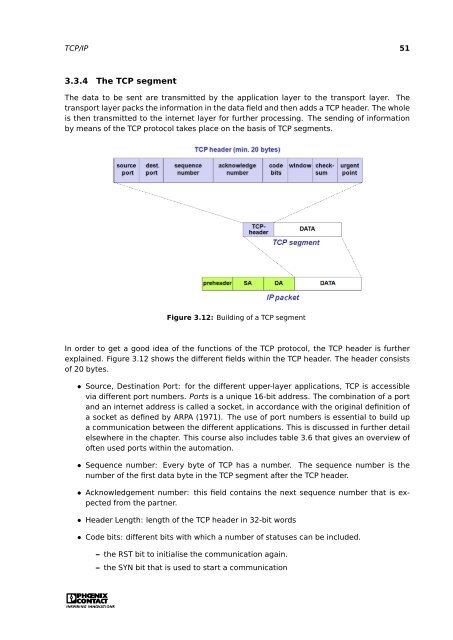Click to download Ethernet Basics manual - Grant Industrial Controls
Click to download Ethernet Basics manual - Grant Industrial Controls
Click to download Ethernet Basics manual - Grant Industrial Controls
You also want an ePaper? Increase the reach of your titles
YUMPU automatically turns print PDFs into web optimized ePapers that Google loves.
TCP/IP 51<br />
3.3.4 The TCP segment<br />
The data <strong>to</strong> be sent are transmitted by the application layer <strong>to</strong> the transport layer. The<br />
transport layer packs the information in the data field and then adds a TCP header. The whole<br />
is then transmitted <strong>to</strong> the internet layer for further processing. The sending of information<br />
by means of the TCP pro<strong>to</strong>col takes place on the basis of TCP segments.<br />
Figure 3.12: Building of a TCP segment<br />
In order <strong>to</strong> get a good idea of the functions of the TCP pro<strong>to</strong>col, the TCP header is further<br />
explained. Figure 3.12 shows the different fields within the TCP header. The header consists<br />
of 20 bytes.<br />
• Source, Destination Port: for the different upper-layer applications, TCP is accessible<br />
via different port numbers. Ports is a unique 16-bit address. The combination of a port<br />
and an internet address is called a socket, in accordance with the original definition of<br />
a socket as defined by ARPA (1971). The use of port numbers is essential <strong>to</strong> build up<br />
a communication between the different applications. This is discussed in further detail<br />
elsewhere in the chapter. This course also includes table 3.6 that gives an overview of<br />
often used ports within the au<strong>to</strong>mation.<br />
• Sequence number: Every byte of TCP has a number. The sequence number is the<br />
number of the first data byte in the TCP segment after the TCP header.<br />
• Acknowledgement number: this field contains the next sequence number that is expected<br />
from the partner.<br />
• Header Length: length of the TCP header in 32-bit words<br />
• Code bits: different bits with which a number of statuses can be included.<br />
– the RST bit <strong>to</strong> initialise the communication again.<br />
– the SYN bit that is used <strong>to</strong> start a communication




